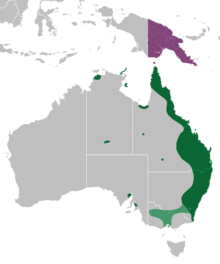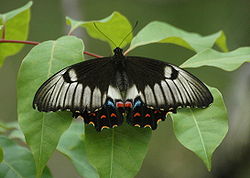- Papilio aegeus
-
Orchard Swallowtail Butterfly Female, Lamington NP, SE Queensland 
Male, Melbourne Zoo Scientific classification Kingdom: Animalia Phylum: Arthropoda Class: Insecta Order: Lepidoptera Family: Papilionidae Genus: Papilio Species: P. aegeus Binomial name Papilio aegeus
Donovan, 1805Subspecies - P. a. aegeus (Donovan, 1805)
- P. a. ormenus (Guérin-Méneville, 1830)

Range of Orchard Swallowtail P. a. aegeus; P. a. ormenusP. a. aegeus temporary rangeSynonyms - Princeps aegeus (Donovan, 1805)
- Papilio (Princeps) aegeus Donovan, 1805
- Menelaides aegeus (Donovan, 1805)
- Papilio (Menelaides) aegeus Donovan 1805
- Papilio erectheus Donovan, 1805
- Papilio erectheus Boisduval, 1832
- Papilio oberon Grose-Smith, 1897
- Papilio doddi Oberthür, 1916
Papilio aegeus, commonly known as the Orchard Swallowtail Butterfly or Large Citrus Butterfly is a species of butterfly from the Papilionidae family, that is found in eastern Australia and Papua New Guinea.
The larvae of this species are sometimes considered a pest, due to the feeding of citrus leaves in suburban gardens.[1]
Contents
Description
Both male and female have black forewings with a white stripe, though there is more white overall on the female forewing. The hindwing is again black, and there is a white swath through the middle. Here the markings differ in that the female has chains of red to orange and blue crescents toward the edge. The markings on the underside are similar to those on top. The body is black.[2] The wing-span is about 140mm in females and 120mm in males,[3][4][5] making it rather large overall and the largest butterfly commonly seen in at least part of its range.[3]
Despite being a swallowtail, which group derives its name from the distinctive tails on the hindwing, this characteristic is entirely absent.
Distribution
Papilio aegeus can be found in every state in Australia except Tasmania and Western Australia, but it is generally found in eastern Australia. It is especially common in Queensland and is the largest butterfly commonly found in Brisbane[3] where there are many citrus trees, on which the larvae feed.[4] During summer, the distribution is temporarily extended to Victoria.
The subspecies P. a. ormenus is found on Papua New Guinea and Thursday Island.
Variation
Subspecies
A differentiating feature between males of the two subspecies, is that the males of P. a aegeus have a red spot on the above side of each hind wing, which is absent in the males of P. a. ormenus.
- P. a aegeus - Eastern Australia
- P. a. ormenus - Papua New Guinea
Forms
Females of both P. a. aegeus and P. a. ormenus have three forms; regular, pale and dark. The pale form has yellow spots on the hind wings, compared to the usual red spots. The front wings are almost completely white. The front wings of the dark form are almost completely black and the hind wings have a smaller white patch.
Life cycle
Egg
The female lays creamy white, smooth, spherical eggs with an approximate diameter of 0.5 millimeters individually on the upper surface of the leaves and shoots of host plants,[6] primarily tropical to subtropical members of the Rutaceae family,[7] which includes introduced and native citrus. The eggs will hatch about one week later.[7]
Larva
The early instars are brown with three white patches, one the: thorax, above the first pair of prolegs, and one on 8th and 9th segment of the abdomen. It is lined with black and white tubercles.[1] The larva only feed on their food plants, citus. Feeding usually takes place during the day and resting on the upper side of leaves during the night, resembling fresh bird droppings.[3]
The later instars are green with irregular white, yellow or brown markings that run diagonally up/back from the bottom edge of the thorax to the 4th and 6th segments. After about four weeks, the larva may have reached a length of 60mm and be ready to pupate.[3]
The larvae are sometimes parasitised by other parasitic insects. Like other swallowtail butterflies, when disturbed, the caterpillar erects it's bright red osmeterium from behind the head, releasing the smell of citrus, to drive predators away.[3]
Pupa
The pupa is colored in cryptic grey, green or brown, depending on the colour of the stem it is attached to. The chrysalis is fastened to a stem of the host plant by means of a cremaster. A thin girdle of silk keeps the head end of the chrysalis uppermost during pupation.[3][6][8] Depending on the season, an imago will emerge from the chrysalis, approximately one-six months later.[1]
Images of Life cycle
-
An early instar caterpillar
-
A later instar caterpillar
-
Female Imago
Larval Foodplants
Although Citrus species are the primary larval foodplants, some other plant species can be eaten by the larvae.
Native
- Boronia
- Citrus
- Clausena
- Dinosperma
- Eriostemon
- Flindersia
- Geijera
- Halfordia
- Leionema
- Micromelum
- Philotheca
- Zanthoxylum
- Zieria
Introduced
- Choisya
- Citrus
- Murraya
- Poncirus
- Zanthoxylum
References
- ^ a b c http://lepidoptera.butterflyhouse.com.au/papi/aegeus.html
- ^ "Butterflycorner". http://en.butterflycorner.net/Papilio-aegeus-Orchard-Swallowtail-Garten-Schwalbenschwanz.530.0.html. Retrieved 2009-06-06.
- ^ a b c d e f g http://www.brisbaneinsects.com/brisbane_butters/Orch_butt.htm
- ^ a b www.soulsong.com.au/Fauna/Butterflies52Orchard.html
- ^ "OzAnimals". http://www.ozanimals.com/index.html. Retrieved 2009-06-06.
- ^ a b "PAPILIONIDAE in Australia". http://staff.it.uts.edu.au/~don/larvae/papi/aegeus.html. Retrieved 2009-06-06.[dead link]
- ^ a b "SOUTH AUSTRALIAN BUTTERFLIES". http://users.chariot.net.au/~erg/aegeus_ds.htm. Retrieved 2009-06-06.
- ^ "Pupa or chrysalis". Encyclopædia Britannica. http://www.britannica.com/EBchecked/topic/336811/lepidopteran/39733/Pupa-or-chrysalis. Retrieved 2009-06-06.
Cited texts
- Braby, Michael F. The Complete Guide to Butterflies of Australia. Corrected edition. Collingwood, Victoria: CSIRO Publishing
External links
Categories:- Papilio
- Lepidoptera of Australia
Wikimedia Foundation. 2010.








